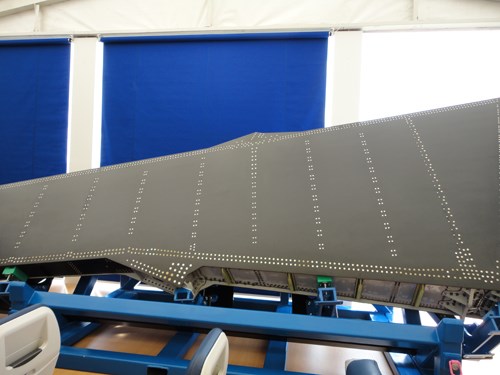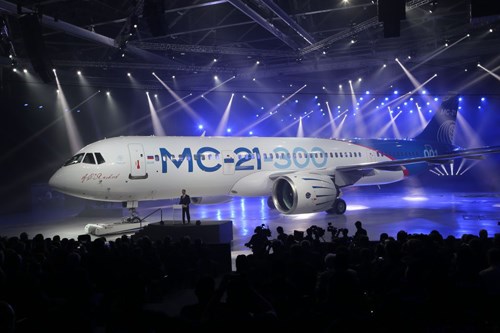MS-21 OOA wing and wing box near first flight
Irkut Corp. rolled out the MS-21 single-aisle commercial aircraft on June 8, and we were reminded of its remarkable novelty: It features the first out-of-autoclave composite wing and wing box.

The MS-21-300, as it was rolled out on June 8 in Russia. It features an aerocomposites first: A wing box, integrated stringers and skins, and spars fabricated entirely out of autoclave. (Note: Irkut refers to the MS-21 to as the MC-21 because the Cyrillic letter “s” looks like the Latin letter “c”)
As Russian aircraft manufacturer Irkut Corp. (Irkutsk, Russia) rolled out its narrow-body MS-21 (132-211 passengers) today (June 8), it’s time to recognize again the novelty of this plane. The MS-21 will carry into the air a major aerospace and composites industry milestone: The first out-of-autoclave (OOA) composite wing and wing box on a commercial aircraft.
As CW reported in early 2014, the MS-21 wing and wing box represent a major and hard-won accomplishment in aerospace composites manufacturing. Never before has such a large, complex and important aerostructure been made OOA. So, it’s worth reviewing now how it was made.


The MS-21 wing box, on display at the Farnborough International Air Show in 2012.
The OOA parts— the wing box, integrated stringers and skins, and spars — are fabricated by AeroComposit (Moscow, Russia), a sister company of Irkut (both are owned by Moscow-based United Aircraft Corp.). The materials used come from Solvay (Cytec when plane development was begun; Woodland Park, NJ, US). The layup is done via placement of unidirectional dry fiber with automated tape laying (ATL) equipment provided by MTorres (Torres de Elorz, Navarra, Spain) and Coriolis (Queven, France).
Lance Parcell, new business development director at Solvay, provided development assistance to AeroComposit starting in 2008 and says the material used, EP 2400, is “a unique product that is toughened and infusible without having to introduce tougheners in other forms like films or polymer fibers.” Further, the resin offers a long window for the infusion process, which provides more than adequate time for large primary structures such as wings. The result, says Parcell, is very low porosity in the final part that “is equal to or less than in an autoclave.”

The MS-21-300 is the longer version of the two that Irkut is manufacturing. It seats 160-211
passengers and is expected to enter service in the 2017-2018 timeframe. The smaller MS-21-200
will follow in 2019-2020.
Parcell says the MS-21 stringers and skins are co-molded in one piece, with the spars and wing box fabricated separately. The co-molding, he says, reduces part count, streamlines assembly and, ultimately reduces final part cost.
“Irkut and AeroComposit were extremely innovative and willing to take risk to make a major leap in the industrialization of infused primary structure,” Parcell says. “It would have been easier to take a conventional autoclave approach. But their aspiration and program objective was to introduce innovation on this airplane.”
The MS-21-300 (160-211 passengers), the baseline model rolled out on June 8, will begin flight testing later this year and is expected to earn certification in the 2017-2018 timeframe. The MS-21-200 (130-176 passengers), is expected to earn certification in the 2019-2020 timeframe.
Related Content
-
A new era for ceramic matrix composites
CMC is expanding, with new fiber production in Europe, faster processes and higher temperature materials enabling applications for industry, hypersonics and New Space.
-
PEEK vs. PEKK vs. PAEK and continuous compression molding
Suppliers of thermoplastics and carbon fiber chime in regarding PEEK vs. PEKK, and now PAEK, as well as in-situ consolidation — the supply chain for thermoplastic tape composites continues to evolve.
-
Plant tour: Joby Aviation, Marina, Calif., U.S.
As the advanced air mobility market begins to take shape, market leader Joby Aviation works to industrialize composites manufacturing for its first-generation, composites-intensive, all-electric air taxi.
















